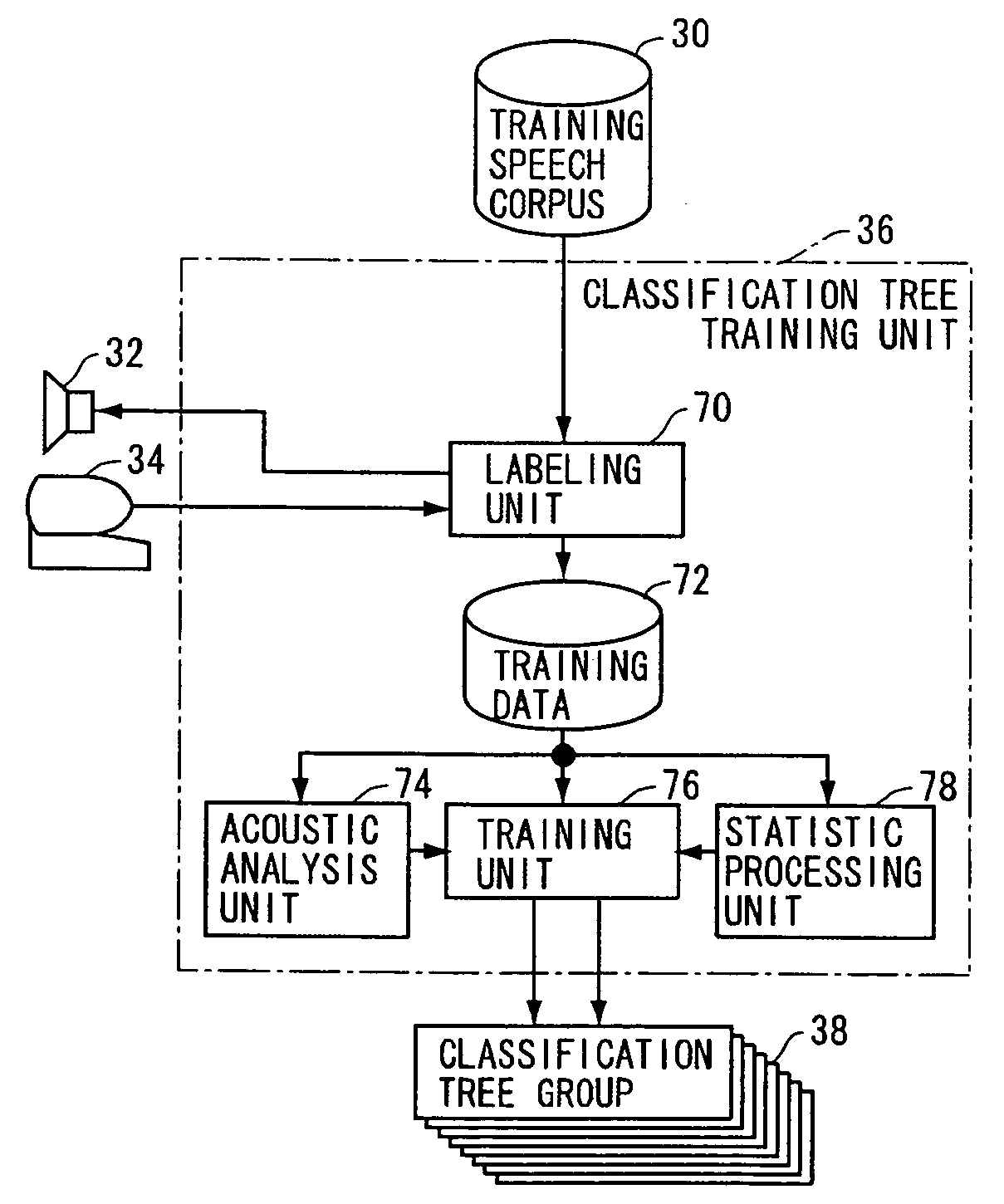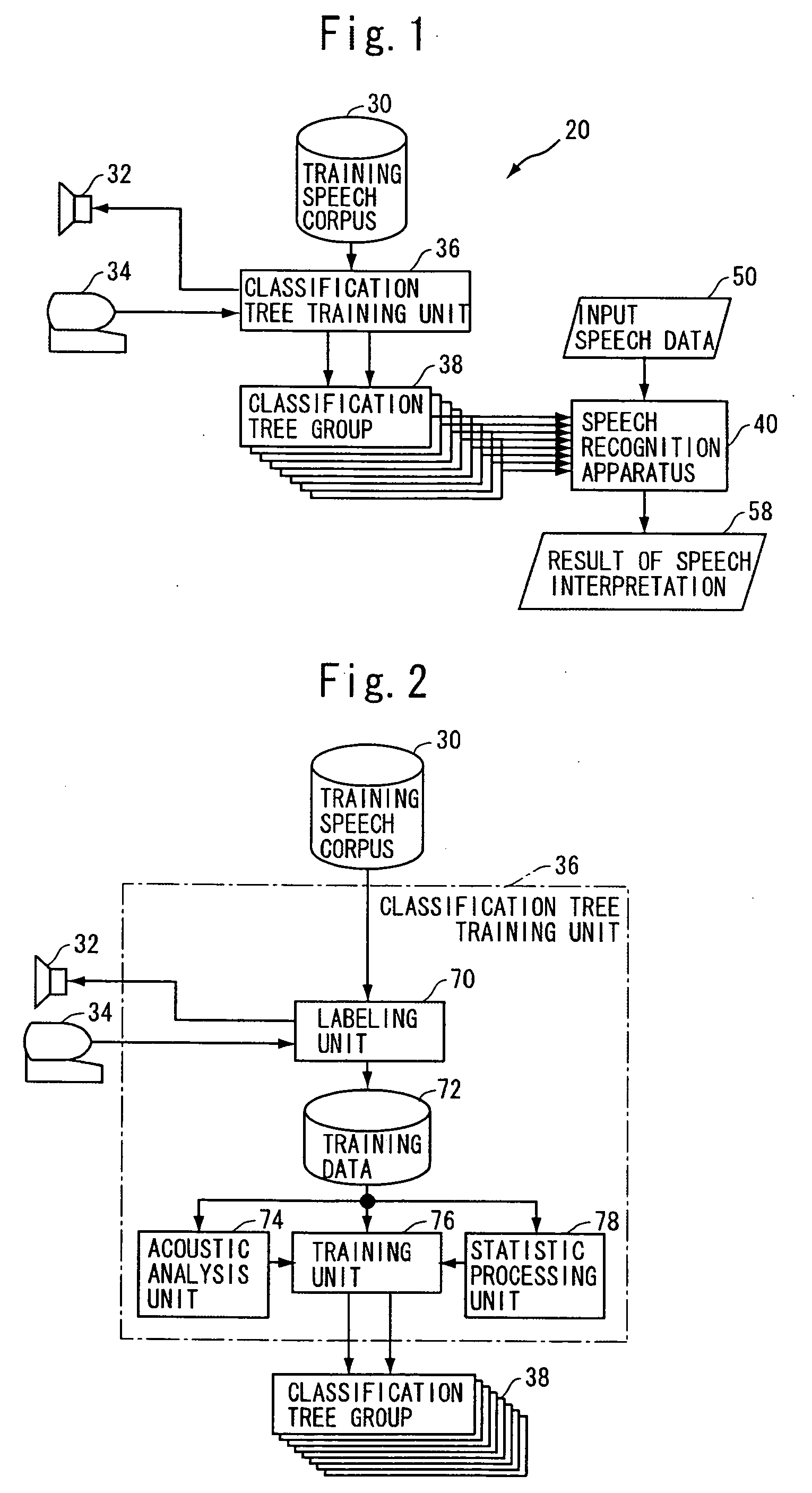Apparatus and method for speech processing using paralinguistic information in vector form
a vector form and speech processing technology, applied in the field of speech processing techniques, can solve the problems of difficult to take out paralinguistic information only from acoustic features of utterances, inability to reliably label, and difficulty in expressing or understanding such feelings
- Summary
- Abstract
- Description
- Claims
- Application Information
AI Technical Summary
Benefits of technology
Problems solved by technology
Method used
Image
Examples
first embodiment
[0036]—Configuration—
[0037]FIG. 1 is a block diagram of a speech understanding system 20 in accordance with the first embodiment of the present invention. Referring to FIG. 1, speech understanding system 20 uses a classification tree group 38 that determines, for each element of the paralinguistic information vector, the probability that the label will be allocated to an utterance of interest, when a predetermined type of acoustic information of the utterances is given. Classification tree group 38 includes classification trees corresponding in number to the elements forming the paralinguistic information vector. The first classification tree outputs a probability that the first element label will be allocated, the second classification tree outputs a probability that the second element label will be allocated, and so on. In the present embodiment, it is assumed that the value of each element of paralinguistic information vector is normalized in the range of [0, 1].
[0038] Noted tha...
second embodiment
[0062] The system in accordance with the first embodiment enables semantic understanding of input speech data 50. Using classification tree group 38 and the principle of operation of the system, it is possible to label each utterance included in a given speech corpus with an utterance intention vector representing semantic information. FIG. 4 shows a schematic configuration of a speech corpus labeling apparatus 80 for this purpose.
[0063] Referring to FIG. 4, speech corpus labeling apparatus 80 includes: classification tree group 38, which is the same as that used in the first embodiment; a speech data reading unit 92 for reading speech data from speech corpus 90 as the object of labeling; an acoustic analysis unit 94 for acoustically analyzing the speech data read by speech data reading unit 92 and outputting resultant acoustic features; an utterance intention vector generating unit 96 for applying the acoustic feature from acoustic analysis unit 94 to each classification tree of c...
third embodiment
[0067]—Configuration—
[0068] The third embodiment relates to a speech synthesizing apparatus using a speech corpus similar to speech corpus 90 having utterances labeled by speech corpus labeling apparatus 80 in accordance with the second embodiment. FIG. 6 is a block diagram of a speech synthesizing apparatus 142 in accordance with the third embodiment. Speech synthesizing apparatus 142 is a so-called waveform connecting type, having the function of receiving an input text 140 with utterance condition information, and synthesizing an output speech waveform 144 that is a natural speech corresponding to the input text and expressing paralinguistic information (affect) matching the utterance condition information.
[0069] Referring to FIG. 6, speech synthesizing apparatus 142 includes: a prosodic synthesis target forming unit 156 for analyzing the input text 140 and for forming a prosodic synthesis target; a paralinguistic information target vector generating unit 158 for generating the ...
PUM
 Login to View More
Login to View More Abstract
Description
Claims
Application Information
 Login to View More
Login to View More - R&D
- Intellectual Property
- Life Sciences
- Materials
- Tech Scout
- Unparalleled Data Quality
- Higher Quality Content
- 60% Fewer Hallucinations
Browse by: Latest US Patents, China's latest patents, Technical Efficacy Thesaurus, Application Domain, Technology Topic, Popular Technical Reports.
© 2025 PatSnap. All rights reserved.Legal|Privacy policy|Modern Slavery Act Transparency Statement|Sitemap|About US| Contact US: help@patsnap.com



